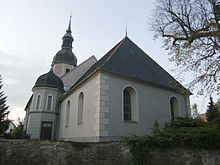Klix (Großdubrau)
|
Klix
Klukš Commune Großdubrau
Coordinates: 51 ° 15 ′ 53 ″ N , 14 ° 31 ′ 32 ″ E
|
|
|---|---|
| Height : | 146 m above sea level NN |
| Residents : | 253 (December 31, 2016) |
| Incorporation : | January 1, 1994 |
| Postal code : | 02694 |
| Area code : | 035932 |
Klix , Upper Sorbian , is a place in the east of the Bautzen district in Saxony and has been part of the Großdubrau community since 1994 . The place lies in the Upper Lusatia and belongs to the settlement area of the Sorbs .
geography
Klix is located in the south of the Upper Lusatian heath and pond landscape about 11 kilometers northeast of Bautzen in the floodplain of the branched Spree , which divides into the Große and Kleine Spree shortly after the town . To the east of Klix there are numerous fish ponds, the largest of which is the Lucasteich .
In terms of settlement history, Klix is a street village parallel to the Spree, which runs to the east, with some extensions, mainly to the north and west. The estate is located on the Spree island at the southern exit of the village. The neighboring towns are Spreewiese in the northeast, Brösa and Guttau behind the ponds in the east, Salga in the southeast, Sdier in the west and Särchen in the northwest.
history
Graves and settlement remains from the Bronze and Iron Ages were discovered in the vicinity of Klix .
Today's place was mentioned for the first time under its present name as a church in 1222 in a document from Bishop Bruno II of Porstendorf and is one of the oldest recorded settlements in Upper Lusatia. Other forms of the name included Clux (1324/1419) and Klucz (1334). A derivation of the place name from "gluck" (aso. Klukati ) is obvious in view of the location in the middle of watercourses, but controversial.
As early as 1282, a mansion based in Klix is recorded, which exercised the manorial rule in the place. The parish church is first mentioned around 1500. It represented the ecclesiastical center of the entire area up to Uhyst .
With the exception of the tower, today's church building was rebuilt in 1893 under the direction of the church builder Theodor Quentin , with a large part of the interior dating from the 16th and 17th centuries.
In the final phase of the Second World War , Klix and the surrounding area were fiercely fought over in the course of the Battle of Bautzen and the front moved across the town three times. 170 German soldiers and 63 nameless soldiers were buried in the Klixer Friedhof.
Until 1994 Klix was an independent rural community, since 1936 with the districts Spreewiese, Särchen and Salga. Then it was incorporated into Großdubrau.
Population and language
Until the end of the 19th century, Klix was one of the largest towns in the area north of Bautzen with between 350 and 400 inhabitants.
For his statistics on the Sorbian population in Upper Lusatia, Arnošt Muka determined a population of 409 in the 1880s; including 390 Sorbs (95%).
On the eve of the Second World War , the entire community had 806 inhabitants. After its end, the population rose to over 1,000 due to the influx of many expellees from the eastern regions. In connection with this, the language change in everyday life from Sorbian to German accelerated. In 1956 Ernst Tschernik still counted 52% Sorbs in the municipality of Klix. Since then, the use of Sorbian in the village has continued to decline. By 1990 the population sank again to below 700.
Economy and Infrastructure
State road 101 (Guttau - Königswartha - Crostwitz ) and district road 7211 to Großdubrau run through Klix . After the opening of the Löbau – Radibor railway in 1906, Klix had its own train station, but it was located in neighboring Sdier. Passenger trains ran until 1972; In 1998 the line was closed.
To the north-west of the town is the Klix airfield , which today is mainly used by glider pilots.
To the west of Klix and south of Sdier are the premises of the agricultural cooperative Heidefarm Sdier e. G. and Edelfleisch GmbH as well as the Klixer Recycling und Service GmbH site not far from there .
Personalities
- Karl Traugott Schütze ( Korla Bohuwěr Šěca ; 1858–1938), botanist and zoologist, father of Theodor Schütze , born in Klix
literature
- Cornelius Gurlitt : Klix. In: Descriptive representation of the older architectural and art monuments of the Kingdom of Saxony. 31. Booklet: Bautzen Official Authority (Part I) . CC Meinhold, Dresden 1908, p. 118.
- Upper Lusatian heather and pond landscape (= values of the German homeland . Volume 67). 1st edition. Böhlau, Cologne / Weimar / Vienna 2005, ISBN 978-3-412-08903-0 , pp. 286ff.
Web links
- Klix (Großdubrau) in the Digital Historical Directory of Saxony
Individual evidence
- ↑ Ernst Tschernik: The development of the Sorbian population . Akademie-Verlag, Berlin 1954.





